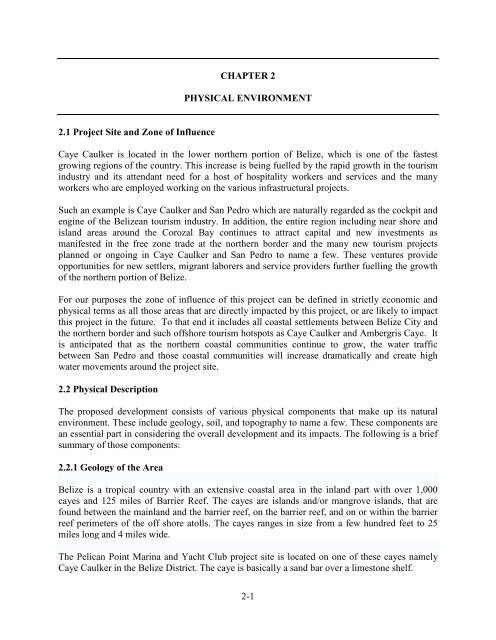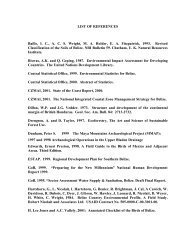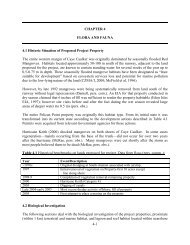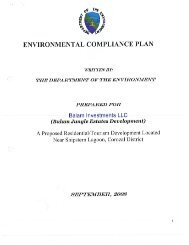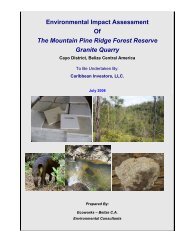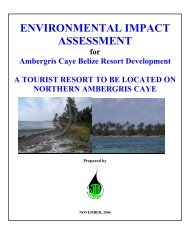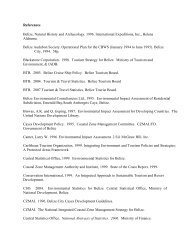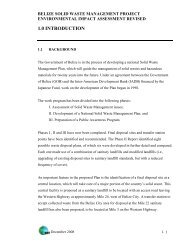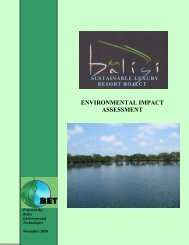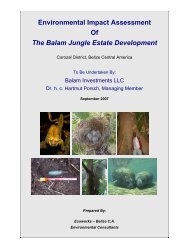Project Environment - Department of Environment
Project Environment - Department of Environment
Project Environment - Department of Environment
Create successful ePaper yourself
Turn your PDF publications into a flip-book with our unique Google optimized e-Paper software.
2.1 <strong>Project</strong> Site and Zone <strong>of</strong> Influence<br />
CHAPTER 2<br />
PHYSICAL ENVIRONMENT<br />
Caye Caulker is located in the lower northern portion <strong>of</strong> Belize, which is one <strong>of</strong> the fastest<br />
growing regions <strong>of</strong> the country. This increase is being fuelled by the rapid growth in the tourism<br />
industry and its attendant need for a host <strong>of</strong> hospitality workers and services and the many<br />
workers who are employed working on the various infrastructural projects.<br />
Such an example is Caye Caulker and San Pedro which are naturally regarded as the cockpit and<br />
engine <strong>of</strong> the Belizean tourism industry. In addition, the entire region including near shore and<br />
island areas around the Corozal Bay continues to attract capital and new investments as<br />
manifested in the free zone trade at the northern border and the many new tourism projects<br />
planned or ongoing in Caye Caulker and San Pedro to name a few. These ventures provide<br />
opportunities for new settlers, migrant laborers and service providers further fuelling the growth<br />
<strong>of</strong> the northern portion <strong>of</strong> Belize.<br />
For our purposes the zone <strong>of</strong> influence <strong>of</strong> this project can be defined in strictly economic and<br />
physical terms as all those areas that are directly impacted by this project, or are likely to impact<br />
this project in the future. To that end it includes all coastal settlements between Belize City and<br />
the northern border and such <strong>of</strong>fshore tourism hotspots as Caye Caulker and Ambergris Caye. It<br />
is anticipated that as the northern coastal communities continue to grow, the water traffic<br />
between San Pedro and those coastal communities will increase dramatically and create high<br />
water movements around the project site.<br />
2.2 Physical Description<br />
The proposed development consists <strong>of</strong> various physical components that make up its natural<br />
environment. These include geology, soil, and topography to name a few. These components are<br />
an essential part in considering the overall development and its impacts. The following is a brief<br />
summary <strong>of</strong> those components:<br />
2.2.1 Geology <strong>of</strong> the Area<br />
Belize is a tropical country with an extensive coastal area in the inland part with over 1,000<br />
cayes and 125 miles <strong>of</strong> Barrier Reef. The cayes are islands and/or mangrove islands, that are<br />
found between the mainland and the barrier reef, on the barrier reef, and on or within the barrier<br />
reef perimeters <strong>of</strong> the <strong>of</strong>f shore atolls. The cayes ranges in size from a few hundred feet to 25<br />
miles long and 4 miles wide.<br />
The Pelican Point Marina and Yacht Club project site is located on one <strong>of</strong> these cayes namely<br />
Caye Caulker in the Belize District. The caye is basically a sand bar over a limestone shelf.<br />
2-1
Fig. 2.1 Geological Map <strong>of</strong> the Area<br />
2-2
Underwater caves are found in the limestone. In front <strong>of</strong> the village, a shallow lagoon between 6<br />
inches and 14 feet deep meets the Belize Barrier Reef to the east. In front <strong>of</strong> the village, the reef<br />
is known as a dry reef with the reef exposed at the surface, while further north the reef is a deep<br />
reef and lies under 8 feet <strong>of</strong> water. Towards the south, at the project site, the water level<br />
gradually descends as one veers westwards.<br />
A narrow waterway known as The Split divides the island in two. Some people state that The<br />
Split was created by Hurricane Hattie in 1961 which devastated Belize City; however others<br />
maintain that it is a man-made feature created by dredging. Though the feature could have been<br />
created by any combination <strong>of</strong> natural and human causes, the lack <strong>of</strong> use <strong>of</strong> The Split by any<br />
except small boats belies any motivation for dredging.<br />
The natives claim that the hurricane first split the island but it was only a foot deep and as people<br />
started getting bigger boats on the island, they decided to dredge it out to roughly 20 feet deep so<br />
the larger boats could pass.<br />
Geologic Age (New Geology Type) Soil Types (Soil Suite)<br />
Unknown (<strong>of</strong>fshore) Acidic Soils (Tintal)<br />
Recent Soils (Turneffe)<br />
Published information on the general ground conditions around the cayes by C.G. Dixon (1956)<br />
indicate that the cayes themselves are sand cayes and there are indications that these are at<br />
present being actively eroded. Dixon describes the cayes in general to have been formed <strong>of</strong> sand.<br />
These sand formations however, overlay flat-top limestone bedrock.<br />
The Geological Map <strong>of</strong> Belize revised edition 2005 establishes the landform in Caye Caulker as<br />
being Quaternary period sand bars, modern reef, calcareous sand and mud from the Holocene<br />
(last 10,000 years) to present (See Fig. 2.1). Deposits <strong>of</strong> this age are a common occurrence close<br />
to ground level, <strong>of</strong>ten forming soils that cover, unconformably, harder and older rock at depth.<br />
The Quaternary (Pleistocene) rocks and modern sediments along the coast, and under water, are<br />
the youngest cycle <strong>of</strong> deposition in Belize, and are represented largely by shallow-water, limey<br />
sediments. Ambergris Caye and adjacent Cayes did not exist then as we know them today. Their<br />
foundation <strong>of</strong> Cretaceous and Tertiary limestone is formed from the accumulation <strong>of</strong> shells and<br />
reef debris like those being deposited today.<br />
2.2.2 Topography<br />
Caye Caulker is a small limestone coral island <strong>of</strong>f the coast <strong>of</strong> Belize in the Caribbean Sea<br />
measuring about 5 miles (north to south) by less than 1 mile (east to west). Caye Caulker is<br />
located approximately 20 miles north <strong>of</strong> Belize City. The proposed project site is located on the<br />
south western-portion <strong>of</strong> the caye adjacent to the Caye Caulker Airstrip. Presently, the project<br />
site has been cleared and leveled for construction.<br />
2-3
The general contour <strong>of</strong> the area shows that the topography commences from a depth <strong>of</strong> 0 feet<br />
near the shoreline to a maximum height <strong>of</strong> 2.5 feet throughout the property. This leveled contour<br />
<strong>of</strong> the project site is as a result <strong>of</strong> previous land clearing activities. Forecasted activities include<br />
elevating the land some 1-4 feet.<br />
Past topographical data concluded that this area was somewhat similar to its present state when<br />
compared to the neighboring topography and land properties. The area was also conducive <strong>of</strong><br />
lush mangrove forest with perennial swamp lands. This particular contour remains flat<br />
throughout the area.<br />
The eastern portion <strong>of</strong> the island is more indicative <strong>of</strong> continuous wave action and sand<br />
transportation dynamics. At this point, general topography is constant with a sand dune<br />
formation that has evolved over the years. These dunes generally have a sharp crest that<br />
gradually slope downwards as one goes inland.<br />
2.2.3 Soil<br />
The subsoil investigation was carried out on the site <strong>of</strong> the proposed development <strong>of</strong> the Pelican<br />
Point Marina and Yacht Club. Probing were conducted on land at various strategic locations and<br />
also carried out in the sea where the proposed marina is to be constructed.<br />
This report describes the site investigation carried out at the site and presents technical<br />
recommendations for the design <strong>of</strong> the structural facilities based on the findings, and also <strong>of</strong> the<br />
associated hazards such as hurricanes and seismic activity that can possibly be encountered at<br />
this site.<br />
The soils investigation for Pelican Point Marina and Yacht Club was carried out and supervised<br />
by Mr. Alberto A. Rosado, a Civil and Structural Engineer assisted by two technicians in<br />
February 2007.<br />
The programme <strong>of</strong> probing was as follows:<br />
BH # 1, 2, 3, 4, 5 February 2007<br />
SB # 1, 2, 3, 4 February 2007<br />
Probes Numbers BH1, BH2, BH3, BH4 and BH5 were conducted on the property upon which<br />
the resort development is being proposed. A development proposal was used to locate the probes<br />
where the main building structures are being considered.<br />
Probes Numbers SB1, SB2, SB3, and SB4 were conducted in the sea immediately in front <strong>of</strong> the<br />
property where the marina for the resort development is being proposed.<br />
The equipment used for this investigation was a Mackintosh Probe manufactured by Engineering<br />
Laboratory Equipment. The probe locations are indicated on the Probe Location Plan (See Fig.<br />
2.2). A more detailed site investigation is presented in Chapter 9 <strong>of</strong> this document.<br />
2-4
Fig 2.2 Probe Locations <strong>of</strong> <strong>Project</strong> Site<br />
2-5
2.2.4 Seismology<br />
The project is not located along any major fault line or zone. The site is located northwest <strong>of</strong> an<br />
unnamed Fault line that runs parallel to the eastern coast <strong>of</strong> the caye and Barrier Reef. This fault<br />
line extends southwards from north Ambergris Caye all the way to Hicks Cayes and also parallel<br />
to the reef. There have been no known epicenters around the project site (See Fig. 2.3).<br />
For Belize, earthquake hazard increases steadily from the north <strong>of</strong> the country to the south as can<br />
be observed in the Maximum Seismic Intensity in Belize (Fig. 2.4). Earthquakes that affect the<br />
country <strong>of</strong> Belize occur in the Gulf <strong>of</strong> Honduras which is the plate boundary zone between North<br />
America and the Caribbean. Belize, on occasion, would experience mild tremors as a result. The<br />
US Geological Survey’s National Earthquake Information Center (NEIC) is responsible for the<br />
tracking <strong>of</strong> all these epicenters and according to the NEIC, Belize would experience a 6.0<br />
magnitude on the Richter scale subterranean earthquake in the ocean approximately every 8<br />
years in the aforementioned fault between Hunting Caye and Puerto Cortez.<br />
The geological faults near the <strong>Project</strong> Site along with the nearby epicenters <strong>of</strong> recent earthquakes<br />
are presented in the Geological Fault Location Map (See Fig. 2.3). With this said, the project is<br />
prone to seismic activity.<br />
It is necessary therefore that the building be designed and constructed in accordance with the<br />
Caribbean Uniform Building Code (CUBIC) or in accordance with any other Code or Standard<br />
approved by the Government <strong>of</strong> Belize.<br />
2.3 Marine Description<br />
The proposed development consists <strong>of</strong> various underwater components that make up the natural<br />
marine environment. These components are important in maintaining the stability <strong>of</strong> the marine<br />
environment and are more susceptible to minor changes as opposed to land alterations. The<br />
following is a brief summary <strong>of</strong> those components.<br />
2.3.1 Oceanography<br />
The area is most heavily influenced by both marine oceanographic process and land derived<br />
influences. This was most aptly demonstrated by the high salinities <strong>of</strong> the area which ranges<br />
from 30-36 ppt that were obtained during the surface water quality testing. Although the field<br />
sampling events was by its nature brief in duration, the floral and faunistic components <strong>of</strong> the<br />
area confirmed the high saline influences <strong>of</strong> the area.<br />
Caye Caulker and in particular the project site is surrounded by the only single body <strong>of</strong> water<br />
which is the Caribbean Sea. More aptly, the caye is located in the coral reef lagoonal system<br />
which is located behind the Mesoamerican Barrier Reef System that has been designated as a<br />
World Heritage Site. Other oceanographic components critical to the stability <strong>of</strong> the underwater<br />
or marine environment involves the movements <strong>of</strong> currents as well as wind and waves.<br />
2-6
Fig. 2.3 Geological Fault Map <strong>of</strong> Belize<br />
2-7
Fig. 2.4 Maximum Seismic Intensity Map<br />
2-8
These sections are briefly summarized and <strong>of</strong>fer a better understanding <strong>of</strong> the marine dynamics.<br />
It is anticipated that the proposed marina will have no significant impacts to the underwater<br />
environment, especially to the flora, fauna, oceanography, waves and currents.<br />
2.3.2 Bathymetry<br />
There has been no published or anecdotal data or information on the depth pr<strong>of</strong>ile or bathymetry<br />
<strong>of</strong> the proposed project area. The bathymetric charts that have been published for Belize are not<br />
<strong>of</strong> a scale or geographic focus to be relevant to the project.<br />
The Tunich Nah Survey Team in its February and March site survey effort has done some<br />
limited work in this area. This survey was undertaken mainly to provide information in regard to<br />
the placement and dimension <strong>of</strong> the large marina that is to be constructed as an integral part <strong>of</strong><br />
the proposed development. Figure 2.5 illustrates the bathymetry pr<strong>of</strong>ile <strong>of</strong> the marine component<br />
<strong>of</strong> the development.<br />
The average depth increases as one progresses seaward. The depth pr<strong>of</strong>ile as one proceeds in an<br />
westward direction from the reclaimed beach, proceeds from ‘0’ depth at the low tide line to<br />
approximately 8 to 10 feet <strong>of</strong> water at 85 to 100 feet from the beach – the depth then gets<br />
progressively deeper up to a distance <strong>of</strong> about 1000 feet. In the mid reaches between the caye<br />
and mainland, the bathymetry gets progressively shallower as one approaches the<br />
aforementioned mainland.<br />
2.3.3 Winds and Waves<br />
The prevailing winds are the main driving force for waves and surface currents in coastal Belize<br />
and by extension the project area. Wind data from the National Meteorological Services near the<br />
PSW Goldson International Airport shows that winds in coastal Belize generally blow from the<br />
northeast, east and southeast at about 5-15 knots. The prevailing wind in the Caye Caulker area<br />
and by extension the project location, is from the east and southeast during the warmer months,<br />
which run from February to September. During the cooler months, from October to January, a<br />
number <strong>of</strong> cold fronts or ‘northers’ affect coastal Belize. During these ‘northers’, which may last<br />
from several hours to 4 – 5 days, the winds blow from the north and northeast over the cayes and<br />
the mainland coast (See Fig. 2.6)<br />
Recent records from the Meteorological Services show that during the cooler months the wind<br />
direction varies equally from the north, the north-northwest and the east-southeast, with<br />
maximum sustained velocities <strong>of</strong> 12 knots. The mean average wind speed for the area varies<br />
from 10-15 knots and on occasion has been less than 5 knots which has been described as<br />
‘gentle’ or ‘mild’.<br />
The project site is relatively exposed to the wind and waves <strong>of</strong>f the western portion <strong>of</strong> the caye.<br />
This is evident in the erosion process that has taken place in recent years.<br />
2-9
Fig. 2.5 Bathymetry and Contouring Map <strong>of</strong> the <strong>Project</strong> Site<br />
2-10
Fig. 2.6 Northerlies and Hurricane Force Wind Patterns<br />
2-11
The western portion <strong>of</strong> the project site is the only exposed area and therefore it is evident that the<br />
erosion process has eroded some <strong>of</strong> the land. In order to prevent erosion, it is anticipated that a<br />
sea wall will be constructed and placed along the coast.<br />
Apart from seasonal variations in wind conditions and sea states, catastrophic storm events are<br />
an attendant risk <strong>of</strong> residing in coastal Belize. Although no site-specific modeling has been done<br />
for Caye Caulker, projections for a Category 5 Hurricane with wind speeds <strong>of</strong> 175 mph entails<br />
storm surges <strong>of</strong> 10-18ft. above mean sea level (MSL).<br />
2.3.4 Tides and Currents<br />
The currents influencing the depositional and erosion processes <strong>of</strong> the proposed project site are<br />
derived from both wind-driven and tidal sources. The wind driven currents are greater in<br />
magnitude and are in general more influential in affecting the dynamics <strong>of</strong> the cayes and the<br />
ecosystems <strong>of</strong> the surrounding waters. Wind driven currents in the Belize have been recorded at<br />
1-1.5 knots at the immediate sub-surface and 0.2-0.6 knots at a depth <strong>of</strong> 1.8 meters (FAO/UNDP<br />
unpublished report, 1983).<br />
The tidal action within the project site is classified as semidiurnal mixed tides, with generally<br />
four peaks in any given tidal day as follows: a high high, a high low, a low high and a low low<br />
tide (Hanson & von Twistern , 1996; National Meteorological Service, pers. com.). Generally<br />
tidal variation is 0.3-0.5 m, raising to 0.8 m during spring tides or associated with storm action<br />
(See Fig. 2.7 for tidal influences).<br />
Tides also affect currents. Narrow cuts such as the Caye Caulker Split funnel can have strong<br />
currents sufficiently fast as to threaten all but those strong swimmers using fins. Channels in the<br />
reef will also reflect tidal currents depending upon their dimensions. Hol Chan Channel also<br />
shows strong current speeds during peak tides, while the larger channels <strong>of</strong>f Caye Caulker<br />
exhibit slower speeds. During the high tides, the currents at the Caye Caulker split and the<br />
channel travel inland and during low tide regress back out to sea. There are also lateral currents<br />
that can affect the project site and impact the reclaimed beach and the moored boats. This lateral<br />
current is neither strong nor prevalent, nevertheless this effect must be mitigated in order to<br />
prevent further beach erosion and to protect the boats whilst moored to the marina.<br />
The prevailing water movement entering the Caribbean is the wind-driven Guiana Current,<br />
flowing from southeast to northwest; this becomes the Caribbean Current, flowing through the<br />
Lesser Antilles with the majority reaching the Yucatan Strait (Hanson & von Twistern, 1996).<br />
The current breaks at Rocky Point, northern Belize, to form a small gyre that drives the sea <strong>of</strong>f<br />
Belize to flow from north to south (Perkins, 1983).<br />
While the prevailing current flow moves from north to south, powerful northerly winds during<br />
cold fronts or other storm events may generate temporary strong currents that may carry<br />
materials such as sediments as far as the Mesoamerican Barrier Reef System (MBRS). These<br />
currents vary seasonally and, though charted in general, have not been studied in detail (Hanson<br />
& von Twistern, 1996).<br />
2-12
Fig. 2.7 Tidal Influences affecting the <strong>Project</strong>.<br />
2-13
2.4 Climatology<br />
Belize has a tropical to subtropical climate with pronounced wet and dry seasons, although there<br />
are significant variations in weather patterns by region. Figure 2.8 illustrates the different rainfall<br />
patterns <strong>of</strong> Belize (Reference <strong>Project</strong> Site).<br />
Average rainfall varies considerably, ranging from 1,350 millimeters in the north and west to<br />
over 4,500 millimeters in the extreme south. Seasonal differences in rainfall are greatest in the<br />
northern and central regions <strong>of</strong> the country where, between January and April or May, fewer than<br />
100 millimeters <strong>of</strong> rain fall per month. The dry season is shorter in the south, normally only<br />
lasting from February to April. A shorter, less rainy period, known locally as the "little dry,"<br />
usually occurs in late July or August, after the initial onset <strong>of</strong> the rainy season.<br />
Groundwater Province(s) Rainfall Range(s)<br />
Coastal Plan & Shelf 40” – 60” (1,016 – 1,524 mm)<br />
The coast <strong>of</strong> Belize is subjected to southeasterly trade winds that average 5-15 knots. The<br />
greatest trade winds are experienced in July. The coastal regions <strong>of</strong> the country get the majority<br />
<strong>of</strong> the winds. Temperatures vary according to elevation, proximity to the coast, and the<br />
moderating effects <strong>of</strong> the northeast trade winds <strong>of</strong>f the Caribbean. Average temperatures in the<br />
coastal regions range from 24° C in January to 27° C in July.<br />
Temperatures are slightly higher inland, except for the southern highland plateaus, such as the<br />
Mountain Pine Ridge, where it is noticeably cooler year round. Overall, the seasons are marked<br />
more by differences in humidity and rainfall than by temperature.<br />
2.5 Ecosystem Pr<strong>of</strong>ile<br />
There is no ecosystem classification for Pelican Point Marina & Yacht Club for the mere reason<br />
that the land has been previously cleared. With that in mind, the consultants attempted to utilize<br />
any historical data that was available, especially around the project site. In so doing, the past<br />
vegetation classification was used. Moreover, in 1998, the Caye Caulker Forest and Marine<br />
Reserve was established. The following sections briefly describe the ecosystem pr<strong>of</strong>ile <strong>of</strong> the<br />
proposed project.<br />
2.5.1Vegetation<br />
Past vegetation maps would put the proposed project site and the refurbished air strip under the<br />
Mangrove with low land littoral forest. This mangrove forest also included wetland mangrove<br />
that frequently became inundated due to the presence <strong>of</strong> the high tides.<br />
The mangrove forest was mostly dominated by the red mangrove and the black mangrove. These<br />
two species were found mostly on the western side <strong>of</strong> the property. Permits were obtained from<br />
the forestry department to alter the mangrove forest. The eastern portion <strong>of</strong> the property were<br />
characterized by a few patches <strong>of</strong> littoral forest which were mostly palms including the Savanna<br />
silver palmetto (Schippia concolor), Palmetto ( Acoelorrhaphe wrightii) and the Common<br />
Coconut Palm (Cocos nucifera).<br />
2-14
Fig. 2.8 Rainfall Map <strong>of</strong> Belize<br />
2-15
2.5.2 Reserves<br />
Stretching five miles long and 1.2 miles wide, Caye Caulker has small but diverse habitats. Its<br />
northern end is completely covered in mangrove vegetation. In 1998, 40 hectares <strong>of</strong> this lush<br />
littoral forest on the northernmost tip <strong>of</strong> the island was acknowledged as the Caye Caulker Forest<br />
Reserve. Over 100 species <strong>of</strong> birds inhabit this lush ecosystem, including the Black catbird and<br />
Rujous-necked wood-rail.<br />
The Marine Reserve forms roughly the figure <strong>of</strong> a seven some 7 miles in length, with the top<br />
portion crossing the caye’s north point and extending into lagoon waters to the west. Area <strong>of</strong> the<br />
marine reserve is 96,661 acres. Today both are conjunctively known as the Caye Caulker Forest<br />
and Marine Reserve (CCFR/MR) (See Fig. 2.9).<br />
2.5.3 Land Uses<br />
There are no particular land uses <strong>of</strong> the area other than for the tourism industry. The caye itself is<br />
composed primarily <strong>of</strong> sand and is characterized by mangrove forests. As a result the tourism<br />
industry has had a major impact on the caye. On the whole, the construction <strong>of</strong> residential and<br />
commercial buildings along with the required infrastructure has left a major footprint on the<br />
island.<br />
2.6 Natural Hazards<br />
The only present natural hazard to affect the caye and in particular the proposed project site are<br />
hurricanes and flooding. The effects <strong>of</strong> major hurricanes over the years have changed the island's<br />
topography in certain areas. The Caribbean, in the last five years, has been severely affected by<br />
hurricanes resulting in substantial economic losses and social dislocation which affect the<br />
sustainability <strong>of</strong> development programs.<br />
Hurricanes have had the most devastating effect on Belize. Belizeans have experienced damage<br />
due to high winds and storm surges. Statistics gathered have shown that the coastal towns and in<br />
particular the cayes <strong>of</strong> Belize are extremely exposed. Flooding can manifests itself as a result <strong>of</strong><br />
the storm surges caused by hurricanes and by extreme high tides that are known to occur on the<br />
caye. Table 2.1 summarizes the potential hazards and its associated risks.<br />
Figure 2.6 shows, the projection and path <strong>of</strong> hurricane force winds along with the northerlies<br />
winds that dominate for some period over the project site. The hurricane winds are circular in<br />
motion and can last for a day or two. These winds generate strong to moderate waves that impact<br />
the coastline, especially on the western coast <strong>of</strong> the caye. The marina will be designed to sustain<br />
a minimal Category Three hurricane. Higher categories can cause catastrophic damages to the<br />
marina. For this reason it will be advisable for the occupants to take their vessel inland.<br />
2-16
Fig.2.9 Map <strong>of</strong> the Caye Caulker Forest and Marine Reserve (Courtesy <strong>of</strong> the Belize Fisheries<br />
<strong>Department</strong>)<br />
2-17
Table 2.1 Vulnerability Studies for Belize<br />
Type Purpose Coverage Date<br />
Produced<br />
Primary Source Author<br />
Hurricane To secure the National May 2001 National<br />
Smith<br />
provision <strong>of</strong><br />
Emergency Warner<br />
regional shelters,<br />
Management International<br />
Flood to institutionally National May 2001 Organization Smith<br />
strengthen the<br />
Warner<br />
National<br />
International<br />
Seismic Emergency National May 2001<br />
Smith<br />
Activity, Management<br />
Warner<br />
Landslides,<br />
Volcanic<br />
Ash<br />
Organization<br />
International<br />
Flood To better National 2001 http://www.oas.org Dr. Ross<br />
understand the<br />
Wagenseil<br />
problem <strong>of</strong> storm<br />
surges and known<br />
extreme<br />
tides<br />
high<br />
Hurricane To access the National February National<br />
Smith<br />
Flooding & vulnerability <strong>of</strong><br />
2000 Emergency Warner<br />
Inundation the site and caye<br />
Management International<br />
Fires to hazards and<br />
Organization<br />
risks<br />
2-18


